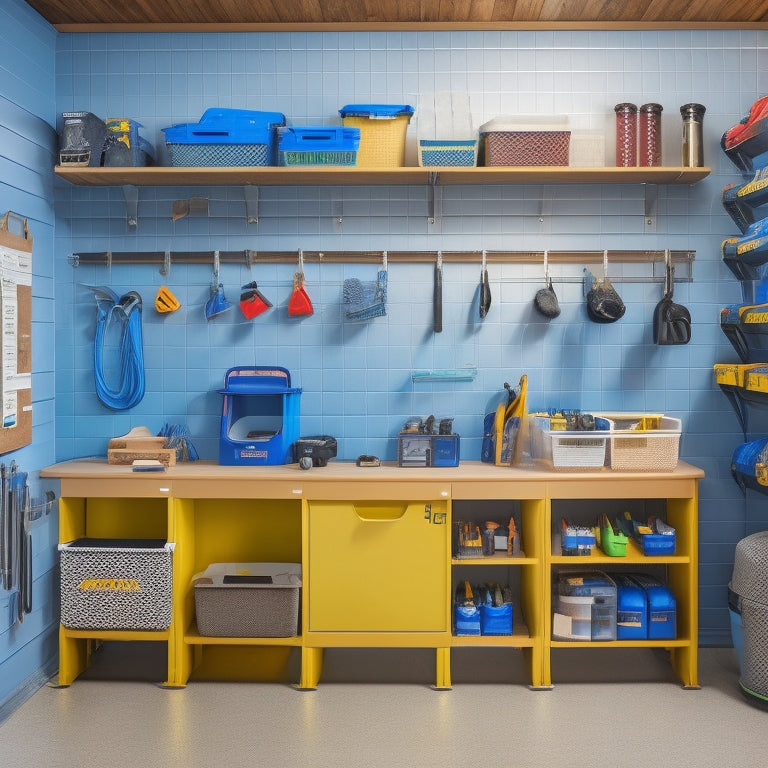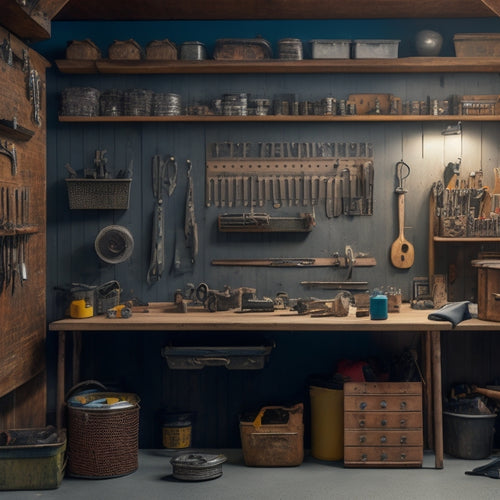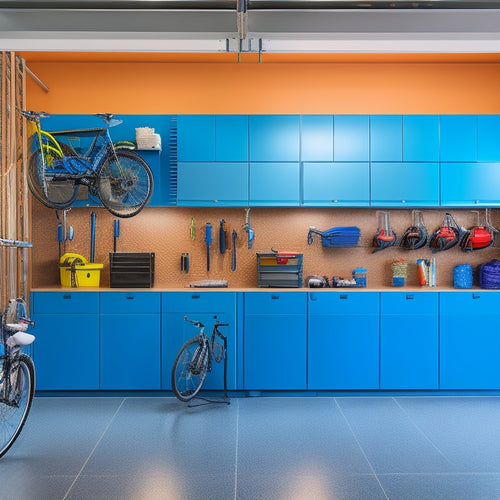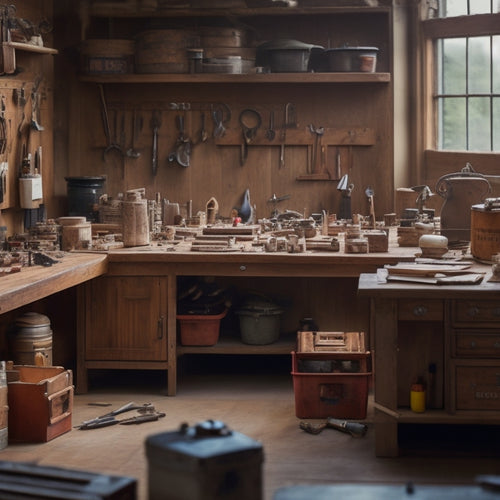
Best Tool Storage Ideas for a Clutter-Free Garage
Share
By optimizing your garage's vertical and ceiling space, you can reclaim your floor area and reduce clutter. Install overhead racks for bulky items and use wall-mounted shelves for smaller ones. Customize your tool cabinets to fit your specific needs, and design a pegboard system that groups similar tools together. Don't forget to store small parts efficiently using bins and magnetic strips, and create a mobile toolbox for on-the-go convenience. Finally, implement a labeling system to quickly identify tools and keep your workspace organized. Now, take the next step to uncover more clever storage ideas and convert your garage into a clutter-free oasis.
Key Takeaways
- Install overhead racks and wall-mounted shelves to maximize vertical storage space and keep frequently used tools within easy reach.
- Design a pegboard system with hooks and bins to organize tools by type and frequency of use, and position it near the workbench.
- Use clear bins and labels to store small parts, and designate a specific area for them to maintain a tidy storage space.
- Invest in a portable toolbox with categorized compartments and durable wheels or handles for easy transport and accessibility.
- Implement a labeling system with clear containers, color coding, and photos to quickly identify tools and enhance organization and safety.
Maximizing Vertical Storage Space
Regularly, homeowners struggle to find space in their garage for all their tools and equipment, but often, the solution lies right above their heads.
You can optimize your garage's vertical storage space by installing overhead racks and wall-mounted shelves. These storage solutions allow you to store infrequently used items, keeping them out of the way but still accessible.
Overhead racks are perfect for storing bulky items like luggage, seasonal decorations, or out-of-season sports equipment. Look for racks with adjustable heights and sturdy construction to guarantee safe and secure storage.
When selecting an overhead rack, consider the weight capacity and verify it can hold the combined weight of the items you plan to store.
Wall-mounted shelves are ideal for storing smaller items like toolboxes, bins, and baskets. They keep your tools organized and within reach, making it easier to find what you need when you need it.
Make certain to follow the manufacturer's instructions for installation to guarantee a safe and secure fit.
Utilizing Ceiling Storage Options
Frequently, homeowners overlook the ceiling as a viable storage space, but it can be a game-changing solution in a cluttered garage. By utilizing ceiling storage options, you can reclaim essential floor space and keep frequently used items within easy reach.
Overhead racks are an excellent way to store infrequently used items like seasonal decorations, luggage, or out-of-season clothing. These racks are typically easy to install and can be adjusted to fit different sizes of storage bins.
When selecting storage bins, choose ones that are sturdy, waterproof, and have secure lids to prevent contents from shifting or falling. Label each bin clearly so you can quickly identify what's inside. Consider investing in bins with built-in handles or grips for easy lifting and carrying.
Remember to always follow safety guidelines when installing overhead racks and loading storage bins. Verify the racks are securely attached to the ceiling, and the bins aren't overloaded, which can cause them to fall or the racks to collapse.
Customizing Tool Cabinets
Many tool cabinets come with standard configurations, but you can customize them to fit your specific needs by adding or rearranging components. This allows you to create a customized storage system that meets your unique requirements and preferences.
When customizing your tool cabinet, consider the materials used. Durable and rust-resistant materials, such as stainless steel or powder-coated metal, can withstand heavy use and harsh garage environments.
Ergonomic design is also essential. Position frequently used tools at waist level to reduce strain and bending. Incorporate adjustable shelves and dividers to accommodate tools of varying sizes. This will enable you to access your tools quickly and safely, reducing the risk of accidents and injuries.
Additionally, consider adding features like soft-close drawers and magnetic strips to keep small parts organized and within reach. By customizing your tool cabinet, you can create a clutter-free and efficient storage system that streamlines your work process and enhances your overall garage experience.
Designing a Pegboard System
Efficiency unfolds when every tool has its designated spot, and a pegboard system is an excellent way to achieve this. By designing a pegboard system, you'll create a centralized hub for your tools, making it easy to find what you need when you need it.
Start by choosing a pegboard that fits your available wall space, and consider the type of tools you'll be storing. You'll want to select pegboard accessories that cater to your specific tool organization needs, such as hooks, bins, and holders.
Plan the layout of your pegboard system thoughtfully, grouping similar tools together and placing frequently used items at eye level. This will save you time and reduce the risk of injury from straining or stretching.
Consider installing a pegboard near your workbench or in a high-traffic area to maximize convenience. With a well-designed pegboard system, you'll be able to quickly identify where each tool belongs, keeping your garage organized and safe.
Storing Small Parts Efficiently
The smallest parts can often cause the biggest headaches when it comes to tool storage. You've spent hours searching for that one tiny screw or bolt, only to find it lost in the depths of your cluttered garage.
To avoid this frustration, you need a system for storing small parts efficiently. You'll want to use small bins and containers to keep similar items together. For example, you can dedicate one bin to screws, another to nuts and bolts, and another to electrical components. Label each bin clearly so you can quickly identify what's inside.
- Use magnetic strips to store small metal parts like screws, nuts, and bolts. This will keep them organized and prevent them from getting lost.
- Designate a specific area of your garage for small parts storage, making it easy to access what you need when you need it.
- Consider using a small parts organizer with separate compartments to keep items separated and organized.
- Keep your small parts storage area clean and tidy, regularly purging any items that are no longer needed or useful.
Creating a Mobile Toolbox
Freedom to roam your garage without being tethered to a fixed workstation is a beautiful thing. With a mobile toolbox, you can take your tools wherever the job requires, without having to constantly return to a fixed location. This flexibility is especially useful when working on large projects that require you to move around the garage.
When creating a mobile toolbox, consider investing in portable toolkits that are specifically designed for mobility. These kits usually come with compact organizers that keep your tools tidy and within easy reach. Look for kits with durable wheels or handles that can withstand the weight of your tools and the rough garage floor.
To maximize the space in your mobile toolbox, categorize your tools by type or frequency of use. Store your most frequently used tools in easy-to-access compartments, while less frequently used tools can be stored in harder-to-reach areas.
Implementing a Labeling System
Get a grip on your tool storage by introducing a labeling system that helps you quickly identify what's inside containers, bins, or drawers. This way, you'll save time searching for the right tool and reduce the risk of accidents caused by misplaced or unidentified tools.
-
Use clear containers or bins with transparent lids to enable easy visibility of contents.
-
Implement color coding to categorize tools by type, function, or project. For instance, you can use red labels for power tools, blue labels for hand tools, or green labels for gardening tools.
-
Label each container or bin with its contents, and consider adding a photo or icon for better recognition.
- Consider using a label maker to create clear, consistent labels that are easy to read, even from a distance.
Repurposing Old Furniture
You're already reaping the benefits of a labeling system, but now it's time to think outside the box - or in this case, the toolbox.
Repurposing old furniture is a great way to create unique and functional storage solutions for your garage. Consider converting an old bookshelf into a storage unit for bins, baskets, and toolboxes. You can also repurpose a vintage dresser to store smaller tools and hardware. Remove the drawers and attach pegboards or hooks to hang items like hammers, screwdrivers, and pliers.
When selecting old furniture for repurposing, make certain it's sturdy and can support the weight of your tools. Sand and refinish the surfaces to protect them from rust and corrosion.
Additionally, add casters or wheels to make the furniture easy to move around the garage. This will allow you to easily reconfigure your workspace as needed.
Frequently Asked Questions
How Do I Prevent Tool Storage From Looking Cluttered and Messy?
To prevent tool storage from looking cluttered and messy, you'll want to implement a labeling system that helps you quickly identify what's stored where, and employ vertical storage solutions to maximize space and keep frequently used items within easy reach.
Can Tool Storage Systems Be Adapted for Small Garages?
You can adapt tool storage systems for small garages by focusing on space-saving solutions like vertical storage units, wall-mounted racks, and compact cabinets, ensuring efficient use of space while maintaining easy access to your tools.
Are Tool Storage Systems Suitable for Renters?
You're a renter who's hesitant to invest in tool storage systems, but consider this: Sarah, a renter in NYC, used portable solutions like stackable bins and space-saving options like adhesive hooks to keep her tools organized without damaging the garage walls.
How Do I Store Hazardous Materials Like Chemicals and Fuels?
You'll want to store hazardous materials like chemicals and fuels in a well-ventilated area, away from heat sources and open flames, using approved containers and following chemical safety guidelines for fuel storage to minimize risks.
Can I DIY My Own Tool Storage System or Hire a Professional?
Like a skilled builder, you're pondering whether to DIY your tool storage system or hire a pro. Weigh the cost considerations: DIY saves bucks, but a professional's knowledge guarantees a safe, efficient space that's worth the investment.
Conclusion
You've optimized your garage storage, and now it's time to reap the benefits! With these tool storage ideas, you'll save time searching for misplaced items and reduce frustration. Did you know that the average person spends around 12 months of their lifetime looking for lost items? By implementing these storage solutions, you'll regain that lost time and enjoy a clutter-free garage that enhances your productivity.
Related Posts
-

Design Considerations for a Custom Pegboard
When designing a custom pegboard, you'll want to start by evaluating your storage needs, considering factors like too...
-

Top Garage Storage Bins for Organization and Style
You can enhance your garage's style and organization with the right storage bins. Top brands like Rubbermaid, Suncast...
-

Top 7 Parts Tray Organizers for Productivity
You can optimize your workspace and enhance productivity with the right parts tray organizer, which can help you cate...


